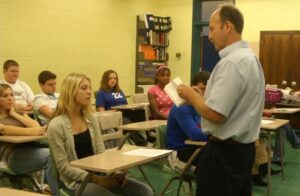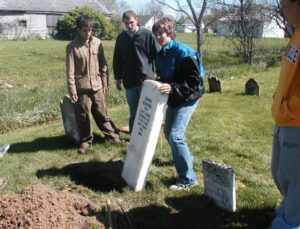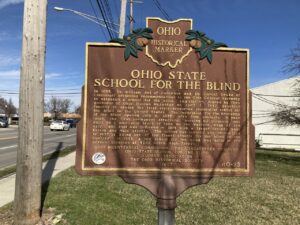Wandering the Stacks and What We Found There
Part 1 of a series that delves into interesting texts found in the Ohio History Connection's Archives & Library
By Paul LaRue, Education Committee co-chair, America 250–Ohio commission
It can be challenging to teach historical perspectives.
In 2014, I was leading a discussion on the events of 9/11/2001 in my high school classroom. As we (adults) often tend to do, I said, “Do you remember where you were on 9/11?” A hand went up, and a student responded, “You know we were two years old in 2001, right?” After the laughter died down, and later when the class had ended I realized the experience had provided me with a valuable insight: It can be challenging to teach historical perspectives.
You may be asking yourself, “why is Paul bringing this up right now?”
Well, The U.S.’s Semiquincentennial is coming up soon on July 4, 2026. Last year on Statehood Day (3/1/22) Governor DeWine announced a new commission called, America 250-Ohio whose purpose is to oversee an inclusive 88-county engagement plan that commemorates the nation’s 250th anniversary. This past fall of 2022, I had the pleasure of co-chairing the K-12 Education Committee with Representative Joe Miller. We were charged to, “…develop ideas that will engage school-age children and educators (especially those who teach social studies) with the work and initiatives of the AM 250-Ohio Commission.” We facilitated calls with brilliant educators from across the state who produced many viable ideas and led discussions on topics such as pedagogy, teacher availability and existing guidelines from the Ohio Department of Education. One of the most well-known of all topics in our nation’s history is the American Revolutionary War.
How history (the American Revolution) is taught in Ohio classrooms.
One of our many discussions focused on the need for foundational knowledge of our nation’s history. In order to understand how the American Revolution is taught in Ohio classrooms is important to understand when the content is to be taught. According to the Ohio Department of Education, the social studies standards are introduced in fourth grade on the Age of Discovery (1400’s) through the end of Reconstruction (1877) in eighth grade. High school history and government discuss the key documents of the time: the Declaration of Independence, the Northwest Ordinance, the Constitution, and The Bill of Rights and work through the major events following the Reconstruction age up to events that took place in 2001. That’s over 1600 years taught in a handful of years. This is not a sustainable standard. There is simply too much American History to cover in any one class.

Paul LaRue teaching at Washington Courthouse High School
When I was a high school student (many years ago), my American history teacher would start over in time with the beginning of the Age of Discovery and then move naturally through the decades. Although I appreciate the extra attention on the Age of Discovery it does not go unnoticed that other events beyond the Civil War (i.e. the Civil Rights Movement, or the events of 9/11) are probably never brought up nor could they be due to the limited time each classroom teacher has with their students each day.
There is so much more to discover about Ohio history.
America 250-Ohio provides an excellent opportunity to provide supplemental content and other educational experiences for existing units. Topics that are featured at many historic sites such as Fort Laurens, the site of a war that occurred during the American Revolution, the tomb of the Unknown Patriot of the American Revolution (both located in Bolivar, Ohio) or the stories of Ohio’s Native Americans make Ohio’s history so rich and fascinating. All of the sites and areas listed throughout this blog may provide teachers with opportunities for enrichment in their classrooms. Please be sure to contact each site directly to see what is available.

Some of Paul’s students replacing a revolutionary war veteran’s grave marker
Teachers will find opportunities to get their students out into their communities to look for local connections to the American Revolution. Revolutionary War Veterans lived in, and are buried in, nearly every county in Ohio. The Daughters of the American Revolution (DAR) have compiled resources to assist teachers and students with this search. The 1840 United States Census contains a useful list of Ohio-Revolutionary War Pensioners
Teachers can engage their students with the lives and final resting places of Revolutionary War Veterans in their communities. Discussions of immigration and diversity naturally follow the stories of these original veterans. Family history is a great way to connect students with their own history, and even possibly to a Revolutionary War Veteran.
America 250-Ohio’s “Ohio Originals” is an opportunity to highlight other unique aspects of Ohio (examples starting at p.9).
Did you know?


The Ohio State School for the Blind is the first state-supported residential school for the blind in the United States; it opened July 4, 1837. Have students explore your community for other “Ohio Originals.”
Learn more. Get Involved.
The America 250-Ohio commission provides teachers, students, families, and communities many opportunities to celebrate and commemorate the United States of America’s 250th Birthday! And don’t feel like you need to wait until 2026 to start your planning. Many communities are already planning something as we speak! Click here to Click here to learn more about America 250-Ohio .
About the author:

A native Ohioan, Paul LaRue grew up in rural Fairfield County. Later he earned his B.S. in social studies education at The Ohio State University and his M.S. in history education from Xavier University. Paul taught social studies at Washington Courthouse High School during his career and has been the recipient of numerous local, state, and national awards. He currently is serving as the Education co-chair for the America 250-Ohio commission as well as continuing to work with social studies teachers and create educational content based on local and national history topics.